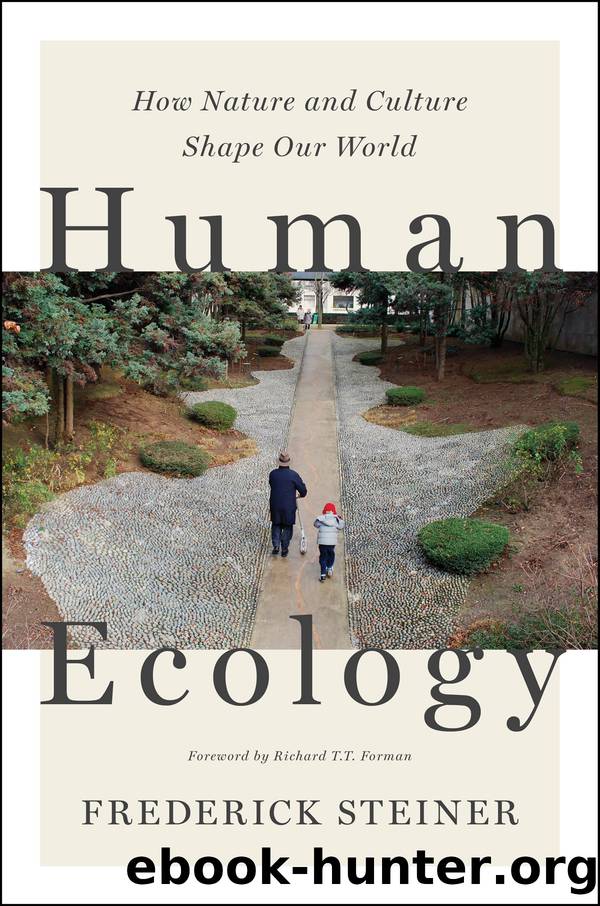Human Ecology by Frederick R. Steiner

Author:Frederick R. Steiner
Language: eng
Format: epub
Publisher: Island Press
Published: 2016-01-20T16:00:00+00:00
REGIONAL PLANNING IN THE UNITED STATES DURING THE LATE TWENTIETH CENTURY
Following the noteworthy beginnings of the early twentieth century, regional planning languished, and for years it was considered an oddity in American academic circles.47 Regional planning was rebounded in the 1960s, but its rebirth came in the form of fraternal twins. For the sake of simplicity, the writings of John Friedmann epitomize one twin, while those of Ian McHarg illustrate the other.48
Friedmann defined regional planning as “concerned with the ordering of human activities in supra-urban space—that is, in any area which is larger than a single city.”49 McHarg would have no doubt accepted this definition, for he described a metropolitan region in the following way: “A city occupies an area of land and operates a form of government. The metropolitan area also occupies an area of land but constitutes the sum of many levels of government.”50
From here, however, each offers widely different perspectives. According to Friedmann, “regional planning theory has evolved out of special theories in economics (location) and geography (central places); [while] city planning theory is based on human ecology, land economics and the aesthetics of urban form.”51 This view of regional planning, based on economics and social science, may be contrasted to McHarg’s natural-science approach. McHarg stated repeatedly that “the world, the city and man as responsive to physical and biological processes—in a word to ecology—are entirely absent from the operative body of planning knowledge. If the planner is part social scientist, part physical planner, he is in no part natural scientist or ecologist.”52
John Friedmann studied in the Program of Education and Research in Planning at the University of Chicago and then taught for many years at the University of California-Los Angeles before retiring in Australia. The Chicago school has pioneered the social sciences since the early twentieth century. For a brief spell, this school provided the leadership in changing the planning profession in the United States by introducing techniques of sociology and economics. As a result, many planners abandoned the environmental design arts and came to think of themselves as applied social scientists. Meanwhile, McHarg revolutionized planning in a different direction. He and his University of Pennsylvania colleagues initiated new ways to apply the biophysical sciences in the planning process.
The sociologist Carl F. Kraenzel proposed an approach to regional planning somewhere between Friedmann and McHarg. According to Kraenzel: “Regionalism, and regional planning, are a recognition that geographic and natural environment forces still set the broad limits within which culture can function. Culture, in cooperating with nature rather than fighting it, can also, within limits, use natural and geographic forces to its own ends. Regionalism and regional planning assist in defining the natural and physical limits within which culture can operate, and aid in pointing the way for a dynamic coordination between culture and natural forces.”53
The ideas about economic fairness and ecological relationships discussed in academic circles during the 1960s started to influence legislation for new regional planning programs in the late 1960s and early 1970s. These programs reflected social and environmental concerns.
Download
This site does not store any files on its server. We only index and link to content provided by other sites. Please contact the content providers to delete copyright contents if any and email us, we'll remove relevant links or contents immediately.
Cecilia; Or, Memoirs of an Heiress — Volume 1 by Fanny Burney(31321)
Cecilia; Or, Memoirs of an Heiress — Volume 3 by Fanny Burney(30927)
Cecilia; Or, Memoirs of an Heiress — Volume 2 by Fanny Burney(30884)
The Great Music City by Andrea Baker(21166)
We're Going to Need More Wine by Gabrielle Union(18063)
Bombshells: Glamour Girls of a Lifetime by Sullivan Steve(13099)
Pimp by Iceberg Slim(12922)
All the Missing Girls by Megan Miranda(12739)
Fifty Shades Freed by E L James(12442)
Norse Mythology by Gaiman Neil(11872)
Talking to Strangers by Malcolm Gladwell(11858)
Crazy Rich Asians by Kevin Kwan(8340)
Mindhunter: Inside the FBI's Elite Serial Crime Unit by John E. Douglas & Mark Olshaker(7827)
The Lost Art of Listening by Michael P. Nichols(6460)
Enlightenment Now: The Case for Reason, Science, Humanism, and Progress by Steven Pinker(6402)
Bad Blood by John Carreyrou(5760)
The Four Agreements by Don Miguel Ruiz(5502)
Weapons of Math Destruction by Cathy O'Neil(5027)
We Need to Talk by Celeste Headlee(4861)
